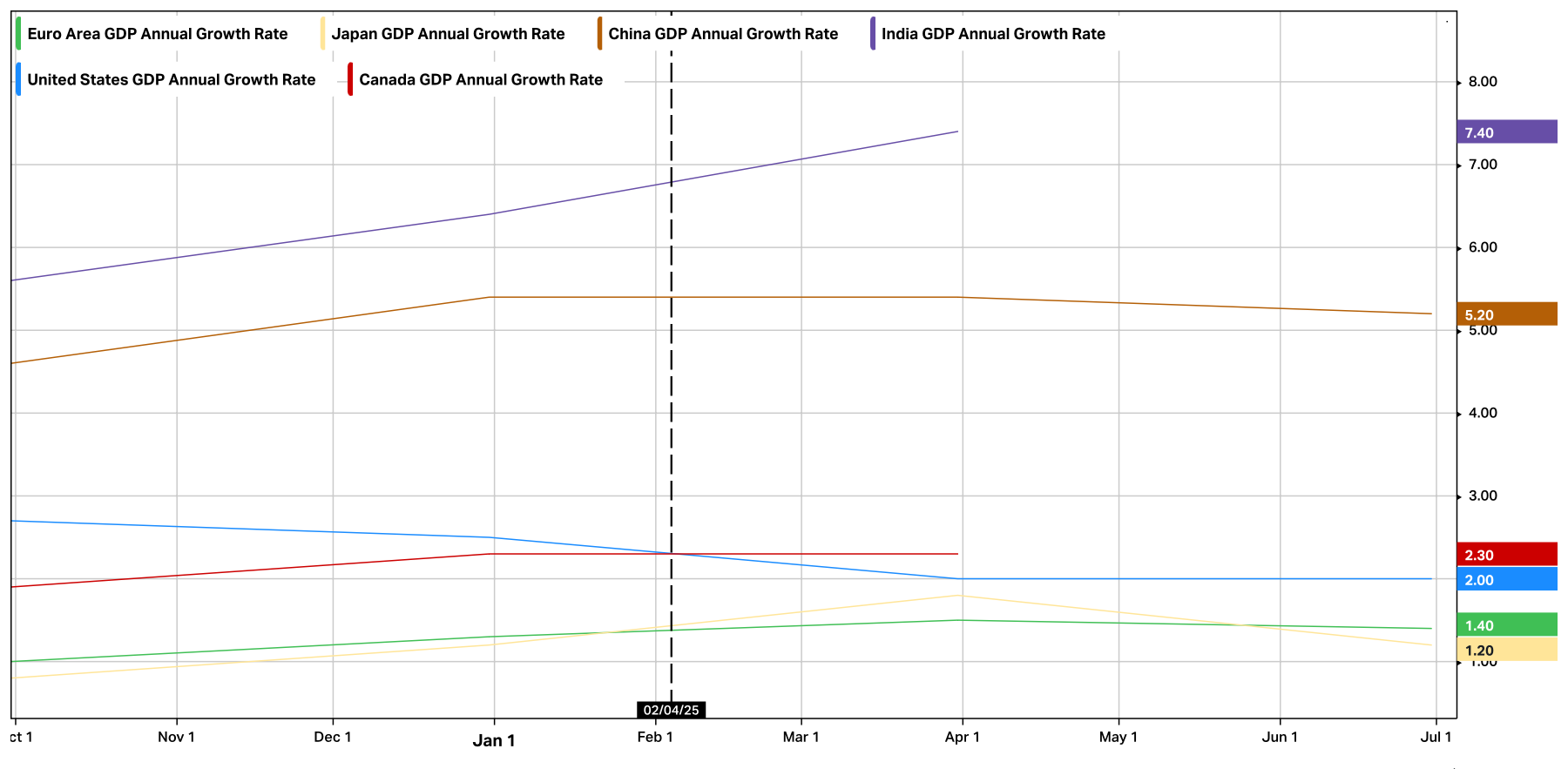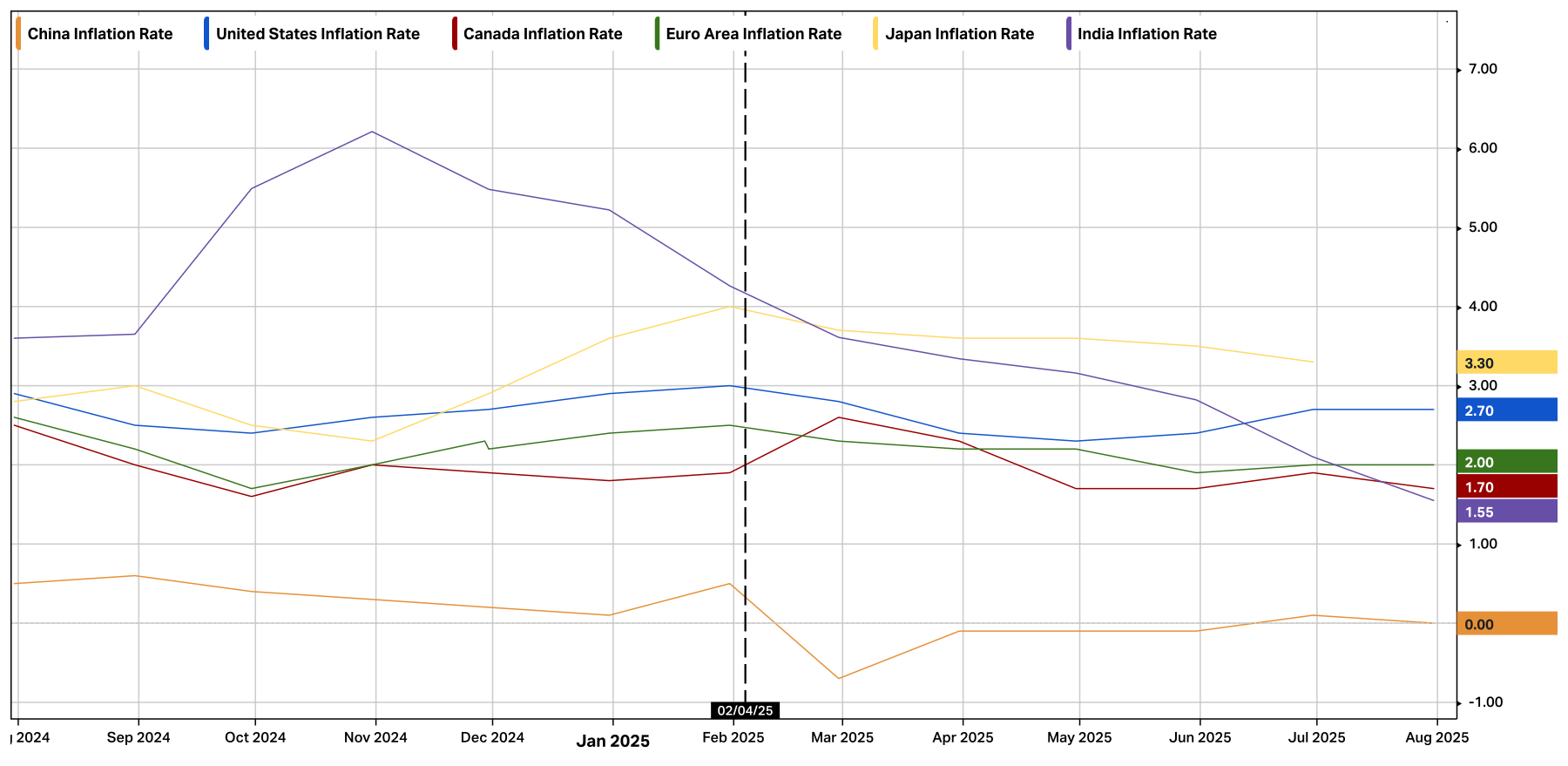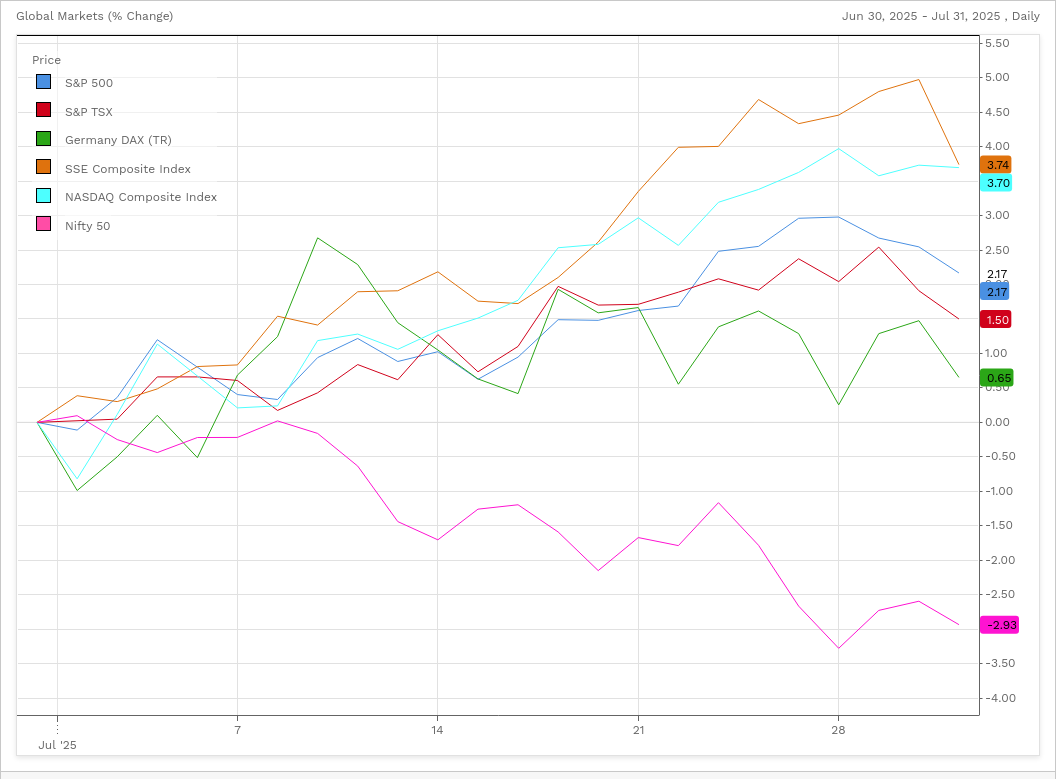| Monthly Market Analysis August 2025 |
ECONOMY
New Tariff Rates
On August 1st tariffs on Canadian goods not covered by the CUSMA (Canada, U.S., Mexico) trade agreement increased from 25% to 35% .The United States announced that on August 27th the tariff rate on Indian goods will increase from 25% to 50%, due to their ongoing purchase of Russian oil.
The United States has more than 200 trading partners and has made trade deals/frameworks with the U.K., Japan, South Korea, the European Union, Vietnam, Indonesia, and the Philippines. Most other trading partners were notified of their tariff rates in a mailed letter.
The Trump administration has proposed a tariff on semiconductors imports at at rate of 100% or more, with exemptions for companies that commit to manufacturing in the United States. They also extended the deadline date to complete a trade deal with China for an additional 90 days.
The United States has eliminated tariff exemptions on goods imported into the United States valued at $800 or less (known as the de minis exemption).
Trump’s Tariffs Note:
Tariffs on American imports are expected to increase the price of goods for American consumers and cut into the profits of American businesses. Nevertheless, the Trump administration has decided to utilize import tariffs to achieve their priorities:
- Tariffs are being implemented to encourage companies to manufacture their products in the United States. The Trump administration expects that companies will eventually produce their products in the United States to avoid tariffs.
- The revenue from tariffs will be used to help pay for the One Big Beautiful Bill Act, passed on July 4th, 2025. The One Big Beautiful Bill act extends expiring tax reduction legislation, which was originally enacted in 2017 during Donald Trump’s first administration, along with other Republican Party priorities. The Congressional Budget Office estimates the cost of extending the 2017 tax cut legislation for ten additional years will be over $4 Trillion.
- Tariffs on U.S goods are being implemented to help eliminate the American trade deficit with other countries. The U.S. tariffs will be used as leverage to coerce other countries to lower their own tariffs and non-tariff barriers.
- Tariffs are being used as punishment for countries that refuse to carry out American demands on a range matters unrelated to trade
Trump’s Tariffs Implemented in 2025
- 35% tariff on Canadian Goods (Except goods covered under the Canada-United States-Mexico trade agreement). Canada is still negotiating lower rates and has implemented counter tariffs.
- 30% tariff on Chinese goods. Negotiation deadline has been extended.
- 15% tariff on Japanese goods. Trade deal framework agreed upon
- 10% tariff on United Kingdom goods. Trade deal framework agreed upon.
- 15% tariff on European Union goods. Trade deal framework agreed upon.
- 25% tariff on Indian goods. 50% tariff rate begins August 27, 2025.
- 25% tariff on Mexican Goods (Except goods covered under the Canada-United States-Mexico trade agreement). Negotiation deadline has been extended.
- 50% tariff on all iron, steel and aluminum imports into the United States except for the United Kingdom and Russia which are tariffed at 25% and 200% respectively.
- 50% tariff on copper imports into the United States.
- 25% tariff on automobiles and automobile parts into the United States, except for the United Kingdom and the European Union which are tariffed at 10% and 15% respectively.
- 10% tariff on all Canadian energy imported into the United States that is not covered under the Canada-United States-Mexico trade agreement.
- 10% tariff on all Canadian and Mexican potash imported into the United States that is not covered under the Canada-United States-Mexico trade agreement.
- 10% – 41% tariffs on all other trading partners based on the size of their trade deficit with the United States.
Conditions under which Trump’s Tariffs will be Lowered or Eliminated
- Legal: Trump’s tariffs mostly contravene international trade law, but enforcing these laws can be a long, tedious process often with no enforceable remedies. American industries that are impacted by Trump’s tariffs often have lobby groups that can challenge the legality of the Trump’s Tariffs in U.S. courts. The United States Congress could also intervene, since tariffs are typically under their purview, but Republicans have a majority in Congress and are unlikely to move against their party leader.
- Political Backlash: The negative impact of higher consumer prices in the United States and/or the unavailability of needed/desired goods due to retaliatory actions taken by other countries may generate political backlash from U.S. consumers and businesses.
- Trade Negotiations: At any time, trade negotiations between the United States and its trading partners around the world could lower or eliminate the newly enacted tariffs.
- U.S. Midterm Elections: In November 2026, U.S. Congressional Elections may change the political environment. If American voters are unhappy with how the Trump’s Tariffs are impacting their lives, Republicans could lose their majority in Congress.
- Four Year Presidential Term: In less than four years Donald Trump will complete his second and final term as the President of the United States of America. A newly elected American President could undo the Trump’s Tariffs, if they are still in place.
| Global Economic Growth (Annual GDP Growth Rate) After Trump’s Tariffs – 1 Year Chart Declining Economies Economic Decline after Trump’s Tariffs United States-0.5% China-0.2% Japan-0.1% Global Annual GDP Growth Rates after Trump’s Tariffs (beginning February 4th): The U.S. economy’s (blue) annual growth rate declined from 2.5% to 2.0%. The Canadian economy’s (red) annual growth rate was unchanged at 2.3%. China’s annual economic growth rate (brown) fell from 5.4% to 5.2%. The Eurozone’s annual economic growth rate (green) increased from 1.2% to 1.4%. The Japanese annual economic growth rate (yellow) declined from 1.30% to 1.20%. India’s annual economic growth rate (purple) increased from 6.4% to 7.4%.  Global Inflation Rates (Annualized) After Trump’s Tariffs – 1 Year Chart Global Annual Inflation Rates after Trump’s Tariffs (beginning February 4th): Since Trump’s Tariffs were implemented the inflation rate for all the tracked economies have moved lower. Canada’s inflation rate (red) declined from 1.9% to 1.7%, United States’ inflation rate (blue) declined from 3.0% to 2.7%, the Eurozone inflation rate (green) fell from 2.5% to 2.0%, China’s inflation rate (brown) declined from 0.5% to 0.0%, Japan’s inflation rate (yellow) fell from 4.0% to 3.3%, and India’s inflation rate (purple) fell from 4.26% to 1.55%.  United States In July, the U.S. economy added a very minuscule 73,000 jobs. The gravity of the low number of jobs generated in July was further exacerbated by downward revisions of May and June’s job numbers. After revisions, it was discovered that only 19,000 jobs were generated in May and 14,000 in June. We will get August’s labour report on September 5th. Although job creation in the United States has slowed dramatically over the last few months, the unemployment rate has held up relatively well. The unemployment rate moved up modestly in August from 4.1% to 4.2%. The quarterly GDP growth rate of the United States economy recovered from -1% in the first quarter of 2025 to 3% in the second quarter. But the annual U.S. GDP growth rate is unchanged at 2%. The U.S. inflation rate was unchanged at 2.7% during the month of July. Inflation in July received upward pressure from automobile, food, and transportation services prices, while falling shelter and energy prices provided downward pressure. During the month of July, U.S. retail sales increased by 0.5% after also advancing 0.9% (revised number) in June. Two positive months of U.S. retail sales confirms that American consumers are continuing to spend despite their concerns about tariffs and inflation. Canada The Canadian economy lost -40,800 jobs in July almost half of the +83,100 jobs it generated in June. The job losses were largest in the information, recreation and culture, and construction sectors. The unemployment rate for the month of July was unchanged at 6.9%. Fortunately, Canada’s inflation rate is on a downward path again, falling from 1.9% to 1.7% in July. Falling interest rates and weaker employment data should provide enough motivation for the Bank of Canada to lower interest rates in their next meeting on September 17th. We will get August’s inflation reading on September 16th. Canadian consumers returned to the stores during the month of June (the latest available preliminary retail data) as retail sales increased by a robust 1.1%. Markets Global Stock Markets The Canadian and U.S. stock markets continued to move in a positive direction in July. Investors remained optimistic as the deadline to negotiate lower tariffs with the Trump administration approached. Trump continues to threaten countries with increasingly higher tariffs, but global equity and bond markets have taken the economic risks in stride. Market participants are less concerned with tariffs, since the expected negative economic impact of tariffs has not shown up in economic data up to now. During the month of July, the U.S. Market (S&P 500) was up 2.17% while the Canadian market (S&P/TSX Composite Index) was up 1.50%. The U.S. Nasdaq Composite index which contains a high weighting of technology related stocks was up 3.70%. The German stock market (Dax 40 index) increased by 0.65%, while the Chinese market (Shanghai Composite Index) increased by 3.74% and the Indian market (Nifty 50 Index) was down -2.93%. Change in Global Stock Markets the Month of July 2025  As of August 8th the new higher tariff rates for countries that have not negotiated a trade deal are in effect. Market sentiment still remains high as many market participants are expecting a rate cut in the next U.S. Federal Reserve meeting on September 17th. The inflation rate, unemployment rate, and the number of jobs created will be the most relevant topics of discussion for members of the U.S. Federal Reserve as they decide whether an interest rate cut is warranted. Prior to the Federal Reserve meeting, we will have the opportunity to see the United States’ August jobs report on September 5th and August inflation data on September 11th. Markets will likely be disappointed and deflated if interest rates are once again left unchanged. |
| 1 (Source: Bank of Canada) 2(Source: Statistics Canada) 3(Source: United States Bureau of Labour Statistics) 4(Source: United States Federal Reserve) 5(Source: United States Census Bureau) 6(Source: FactSet as of July 31, 5:00 PM) |
* This information has been prepared by Desmond Rubie, BCom, FCSI®, CIM®, CFP®, who is a Wealth Advisor for Rubie Wealth Management Group at iA Private Wealth. Opinions expressed in this article are those of Desmond Rubie, BCom, FCSI®, CIM®, CFP® only and do not necessarily reflect those of iA Private Wealth Inc.
*IA Private Wealth Inc. is a member of the Canadian Investor Protection Fund and the Canadian Investment Regulatory Organization. iA Private Wealth is a trademark and business name under which iA Private Wealth Inc. operates.

Desmond Rubie, BCom, FCSI®, CIM®, CFP®
Wealth Advisor
Rubie Wealth Management Group | iA Private Wealth
Insurance Advisor | iA Private Wealth Insurance*
26 Wellington Street East, 2nd Floor
Toronto, ON M5E 1S2
T: 647-429-3281 ext. 240018
Desmond.Rubie@iaprivatewealth.ca
rubiewealth.com
Fellow of CSI (FCSI®)
iA Private Wealth Inc. is a member of the Canadian Investor Protection Fund and the Canadian Investment Regulatory Organization. iA Private Wealth is a trademark and business name under which iA Private Wealth Inc. operates.
*Insurance products are provided through iA Private Wealth Insurance, which is a trade name of PPI Management Inc. Only products and services offered through iA Private Wealth Inc. are covered by the Canadian Investor Protection Fund.

Leave a Reply